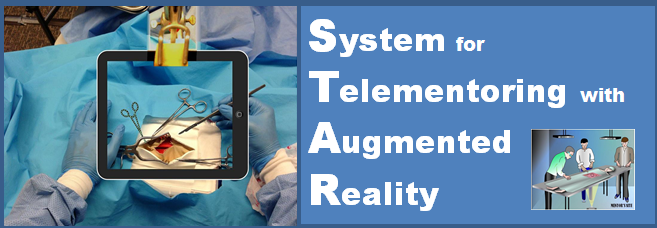Sponsor: Office of the Assistant Secretary of Defense for Health Affairs
Description: With the System for Telementoring with Augmented Reality (STAR), we want to increase the mentor and trainee sense of co-presence through an augmented visual channel that will lead to measurable improvements in the trainee’s surgical performance.
Our project has four specific aims. First, we will research, develop, and assess a transparent-display augmented-reality system that allows the seamless augmentation of a trainee surgeon’s nautral view of the surgical field with annotations and iluustrations of the current and next steps of the surgical procedure. Second, we will research, develop, and assess a patient-size interaction platform where the mentor can mark, annotate, and zoom in on anatomic regions using gestures perfromed over a projected image or on a multipoint touch screen. Third, we will validate and refine the proposed STAR platform in the context of practice criothyroidotomy procedures on a human-patient simulator in a controlled environment. Fourth, we will validate the refined STAR platform in a simulated austere environment. The environment will match, for example, a military echelon Role 2 medical facility, consistent with a forward surgical team with limited resources. A hemorrhage-control procedure will be done within a damage-control laparotomy on a porcine model.
The STAR project has a military significance. There are three more areas where our proposed system has the potential to improve quantitative and qualitative outcomes in the military healthcare setting. First, telementoring can avoid or diminish the loss of surgical skills through retraining and competence. Second, it will be useful to provide instructional material in a simulation form, to support doctors serving in Iraq and Afghanistan in traumatic care in the battlefield, in a portable and dynamic style. Finally it will allow recent combat medic graduates to reinforce surgical techniques that were not conceptualized during their training curricula.
